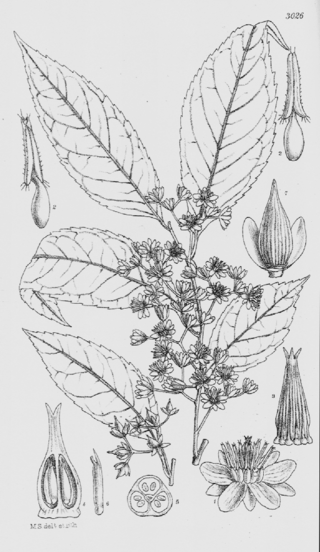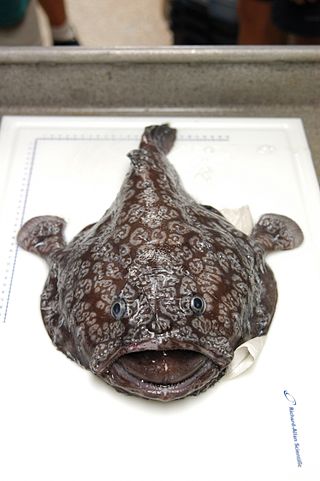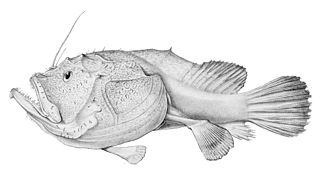
Clematis is a genus of about 380 species within the buttercup family, Ranunculaceae. Their garden hybrids and cultivars have been popular among gardeners, beginning with Clematis 'Jackmanii', a garden staple since 1862; more cultivars are being produced constantly. They are mainly of Chinese and Japanese origin.

Abelia is a genus of flowering plants in the honeysuckle family, Caprifoliaceae. The genus currently includes six species native to China, Taiwan, and Vietnam.

Banksia subg. Banksia is a valid botanic name for a subgenus of Banksia. As an autonym, it necessarily contains the type species of Banksia, B. serrata. Within this constraint, however, there have been various circumscriptions.

Banksia integrifolia, commonly known as the coast banksia, is a species of tree that grows along the east coast of Australia. One of the most widely distributed Banksia species, it occurs between Victoria and Central Queensland in a broad range of habitats, from coastal dunes to mountains. It is highly variable in form, but is most often encountered as a tree up to 25 metres (82 ft) in height. Its leaves have dark green upper surfaces and white undersides, a contrast that can be striking on windy days.

Banksia ser. Salicinae is a valid botanic name for a series of Banksia. First published by Carl Meissner in 1856, the name has had three circumscriptions.

The taxonomy of Banksia integrifolia has a long and complex history, the result of confusion caused by the species' great variability, and similarities with some closely related species. The existence of hybrids between B. integrifolia and related species as well as early attempts to classify the species based on dried specimen material have also contributed to the confusion.

Banksia integrifolia subsp. integrifolia is a subspecies of Banksia integrifolia.
Carl Meissner's taxonomic arrangement of Banksia was published in 1856, as part of his chapter on the Proteaceae in A. P. de Candolle's Prodromus systematis naturalis regni vegetabilis. It was the first attempt to provide an infrageneric classification for the genus, aside from Robert Brown's publication of two subgenera in 1810. Meissner's arrangement stood until 1870, when it was superseded by the arrangement of George Bentham. Meissner's arrangement was an excellent survey of the known species at that time, but his infrageneric taxa were all highly heterogeneous.

Alex George's taxonomic arrangement of Banksia was the first modern-day arrangement for that genus. First published in 1981 in the classic monograph The genus Banksia L.f. (Proteaceae), it superseded the arrangement of George Bentham, which had stood for over a hundred years. It was overturned in 1996 by Kevin Thiele and Pauline Ladiges, but restored by George in 1999. A recent publication by Austin Mast and Kevin Thiele suggests that it will soon be overturned again.

Sladeniaceae is a family of flowering plants containing tree species found in subtropical to tropical environments in East Africa (Ficalhoa), Burma, Yunnan, and Thailand (Sladenia). The family consists of trees with alternate, simple leaves without stipules, and flowers arranged in cymose inflorescences.

Macadamia integrifolia is a small to medium-sized tree, growing to 15 metres in height. Native to rainforests in south east Queensland and northern New South Wales, Australia. Common names include macadamia, smooth-shelled macadamia, bush nut, Queensland nut, Bauple nut and nut oak.

Sladenia shaefersi, the Atlantic twospine goosefish or Shaefer's anglerfish, is a species of marine ray-finned fish belonging to the family Lophiidae, the goosefishes, monkfishes and anglers. This species is found in the western Atlantic Ocean.

Sladenia is a genus of marine ray-finned fishes belonging to the family Lophiidae, which includes the goosefishes, monkfishes and anglers. These are deepwater anglers found in theIndian Ocean, the Caribbean Sea and the Western Pacific Ocean.

Caruso brachysomus is an extinct species of ray-finned fish belonging to the family Lophiidae, the goosefishes, monkfishes and anglers, within the order Lophiiformes, the anglerfishes. It was described by Louis Agassiz in 1835 from the Monte Bolca locality. It became extinct during the middle Eocene.
Sladenia is the scientific name of several genera of organisms and may refer to:

Zamia integrifolia, also known as coontie palm, is a small, tough, woody cycad native to the southeastern United States, the Bahamas, Cuba, and the Cayman Islands.
Sladenia integrifolia is a species of tree in the family Sladeniaceae found in southern Yunnan, China. Its type locality is Zhemi Township, Jinping Miao, Yao, and Dai Autonomous County, southern Yunnan, China.
Sladenia celastrifolia is a species of tree in the family Sladeniaceae found in southwestern China, Thailand, and Myanmar.

Sladenia gardineri, the Indian round angler, is a species of marine ray-finned fish belonging to the family Lophiidae, the goose fishes, monkfishes or anglers. This species is found in the Indo-Pacific.

Sladenia zhui, Chu's rounded angler, is a species of marine ray-finned fish belonging to the family Lophiidae, the goosefishes, monkfishes and anglers. This species is found in the western Pacific Ocean.












